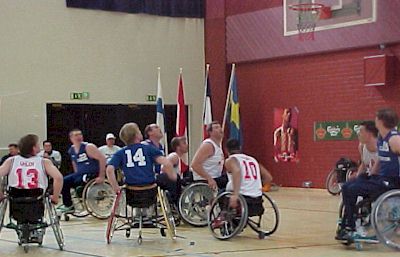
Wheelchair Basketball
HISTORY OF WHEELCHAIR BASKETBALL
An historical perspective on wheelchair basketball would not be complete without mention of the second World War (1939-1945). One end result of this global crisis was that society was confronted with an unusual number of people with physical disabilities. These people let the world know that they had needs that had to be met beyond food, clothing and shelter; they had an ego, they were worthwhile, and they belonged!
The philosophy of the day was adaptation of particular sports as viewed through the eyes of rehabilitation staff. Basketball was perceived to be one of the most adaptable team sports, and was played in various parts of the world in the early 1940's.
On the world scene, Sir Ludwig Guttmann was given the task of starting a spinal cord injuries centre at Stoke Mandeville Hospital in Aylesbury, Buckinghamshire, England. The British Government funded the operation in 1944 with the view of having the second front assist individuals to cope with their disability, regain dignity and independence that may have been lost, and become happy, healthy and respected members of the community. The Stoke Mandeville World Wheelchair Games in 1948 marked the beginning of organized wheelchair sports, and earned Sir Ludwig Guttmann the distinction of becoming recognized as the founder.
It is now played in more
than 80 countries, including Canada, by over 25,000 men, women and children
with a physical disability which prevents them from playing competitive
basketball on their feet. The game is played at local, regional,
national and international levels.
WHEELCHAIR BASKETBALL PLAYING RULES
The IWBF develops, monitors and revises the playing rules of wheelchair basketball to reflect developments within the sport, and where practicable, to be consistent with the FIBA rules. The FIBA playing rules are followed with only minor amendments to accommodate the wheelchair. For example, a player is allowed two pushes on the wheels of the wheelchair before he/she must dribble, pass or shoot the ball. Additionally, the wheelchair is considered a part of the player for all contact and boundary violations.

TEAM BUILDING: THE WIDER PERSPECTIVE
New players to wheelchair
basketball will experience the thrill of team cooperation and success.
Wheelchair basketball serves as an example to the world of how team sport
should be played and how the success of the team is paramount to the success
of the individual players. Wheelchair basketball spectators are immediately
focused on athletic ability rather than a preconception of disability.
The excitement, friendship and understanding that occur through sport transcend
many former attitudinal barriers.
DEVELOPMENT AND EDUCATION
The IWBF
provides information and educational resources on wheelchair basketball
in many languages and publishes a newsletter, Basketball News, three
times a year for member nations. IWBF competitions and development
clinics serve as opportunities for publicity for wheelchair basketball.
Thousands of individuals are introduced yearly to wheelchair basketball
through direct exposure at wheelchair basketball competitions or through
educational programs. Through televised matches and highly publicized events
such as the Paralympic Games and World Championships, wheelchair basketball
is proving to be a real sports enthusiastís sport.
Home |Paraplegia| Shooting | Evaluation of Learning